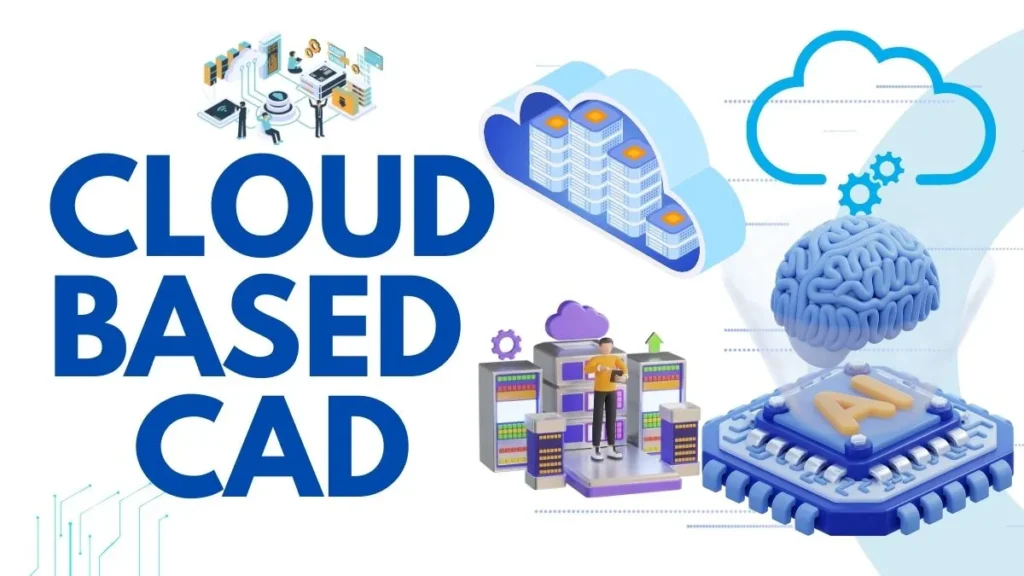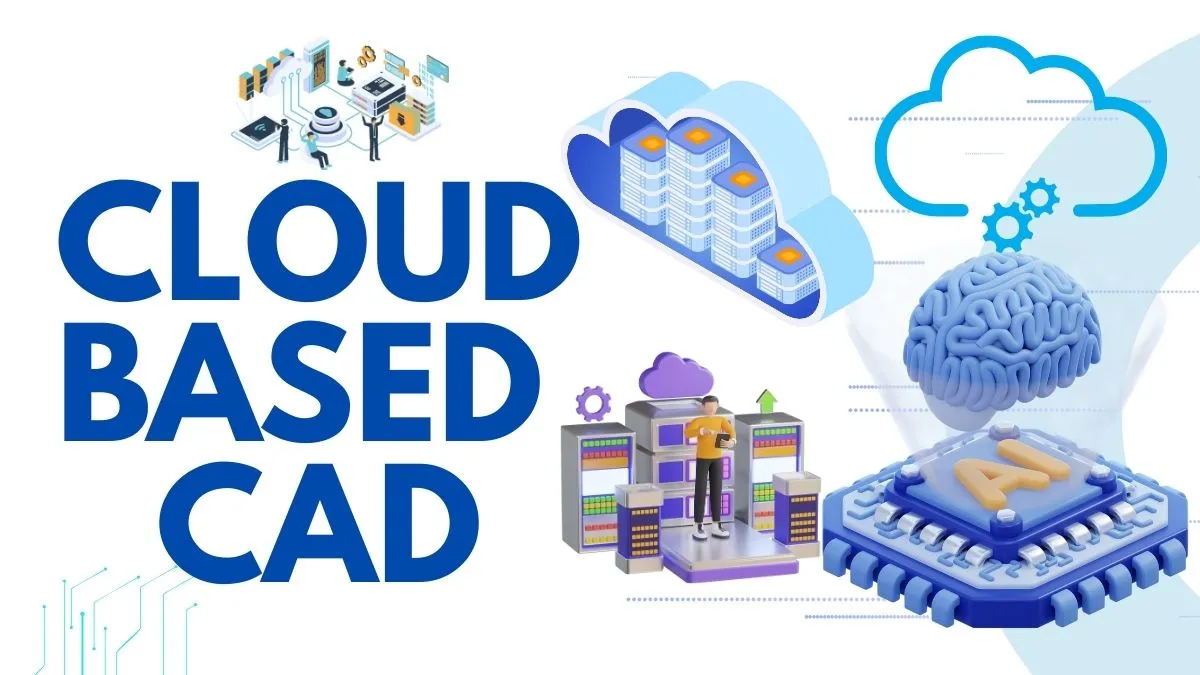Learn how cloud-based CAD Software’s are changing the way designers design, engineers think, and students get to work. Learn there features, benefits, challenges, and future trends in this complete guide mentioned in this blog.
Introduction: A New Chapter in CAD
If you’ve ever worked with CAD (Computer-Aided Design), you already known about how powerful and essential it is for engineering, architecture, and manufacturing. But you might also remember the headaches of installing heavy software, buying high-end graphics computers, and paying huge license fees, which a normal person can’t afford.
Well, things have now changed. Thanks to cloud-based technology, CAD has now moved online. No bulky downloads, no worrying about hardware requirements. With cloud-based CAD software, you can design, edit, and share your projects directly from a browser, just like you’d use Google Docs, Google Sheets.
This shift is not just a small update—it’s a beginning of big revolution in the design world.

Table of Contents
What is Cloud-Based CAD?
CAD means a design which is created by computer and Cloud means online, So Cloud-based CAD simply means a CAD that runs on the internet. Instead of installing the program on your system, the software lives on remote servers, and you can access it through the cloud i.e on internet.
Just Imagine this:
You open your laptop, log in, and your designs are there waiting.
You don’t need to buy heavy-duty setup configuration to run heavy and complex designs.
All the Updates get updated automatically, so you will always use the latest version.
In short, cloud CAD is CAD made simple, flexible, and connected.
Why Cloud-Based CAD will change the Game
Here’s why so many professionals and students are switching to the cloud-based technology:
- Design from Anywhere: Whether you’re at the office, at home, or even you are traveling, your designs are can be accessible all time. Just log in to your account and continue from where you left.
- Smooth Team Collaboration: Remember the Hectic of sharing design files via email or pen drives? Cloud CAD ends this now. You and Your Teams can work together in real time, just like editing a shared Google Sheet.
- Cost-Friendly: Traditional CAD often requires a one-time license worth thousand or may be lakhs also But with Cloud CAD, it basically comes with a monthly or yearly subscription, making it budget-friendly for startups, freelancers, and specially for students.
- Automatic Updates: No more waiting for IT teams to install the latest patch and updates. With cloud CAD, updates are updated very fast. You will always use the latest tools.
- Perfect for Remote Work: cloud CAD keeps design teams connected no matter where they are whether in remote area or at urban area.
Cloud CAD vs Traditional CAD
| Feature | Traditional CAD | Cloud CAD |
| Installation | Heavy setup required | Runs online in a browser |
| System Needs | High-end PC required | Works on regular devices |
| Collaboration | Manual file sharing | Real-time teamwork |
| Cost | Expensive one-time license | Affordable subscription |
| Updates | Manual installation | Automatic updates |
| File Storage | Local hard drive | Secure cloud storage |
It is clear that cloud CAD wins in most areas for best and modern workflows.
Popular Cloud CAD Software in 2025
These tools are now trending:
- Fusion 360 (Autodesk): Great for product design in 2D & 3D with simulation and manufacturing tools.
- On shape: 100% cloud-based which is excellent for collaboration and version control.
- SketchUp Web: Perfect for architects and interior designers who prefer simple tools to make the things perfect.
- Tinker cad: Beginner-friendly and mainly used in schools for 3D printing.
Benefits of Cloud CAD
- Work from any device, from anywhere.
- No huge software purchasing costs.
- Easy to uses, user friendly with teamwork and can share easily.
- No chance of missing file. Files stored safely in the cloud.
- Always up-to-date with the latest features and tools for best performance.
Disadvantages of Cloud CAD
- You must have a stable internet connection and good connectivity.
- Subscription fees can be increasing any time.
- Not all tools work online, some work offline only.
- Security Issue for highly confidential projects and files.
How Different Industries Use Cloud CAD
- Architecture & Civil Engineering: Architects can share real-time project updates with their clients and customers.
- Mechanical & Automotive: Engineers can test and optimize parts faster, which increase overall speed of the project.
- Electronics & Electrical: Circuit and PCB design collaboration becomes easier, which will enhance the productivity.
- Education: Affordable for schools and colleges to train students instead of buying heavy setup and software’s.
The Future of Cloud CAD
The journey will not stop here. In the coming years it will bring AI-driven design, VR/AR-based 3D visualization, and smarter simulations. Imagine walking through your design in virtual reality or letting AI generate optimized design alternatives for you.
The future of CAD is very big.
FAQs on Cloud-Based CAD
Q1: Do I need a powerful PC for getting started with cloud CAD?
Ans. Not really, Since the heavy processing happens on cloud servers, even a basic laptop can run it.
Q2: Is my data safe on cloud CAD platforms?
Ans. Yes. Most providers use strong encryption and backups, though you should always check security policies and always have offline backup of your files.
Q3: How many people can work on the same design at once?
Ans. Absolutely Yes, Cloud CAD supports real-time teamwork and avoiding duplicate files.
Q4: Is it cheaper than traditional CAD?
Ans. Usually, yes. Subscriptions cost less than buying a heavy license of a software.
Q5: What’s the biggest drawback?
Ans. A stable internet connection is essential—without it, cloud CAD won’t work smoothly.
Conclusion: The Future of Design is in the Cloud
Cloud-based CAD is not just a trend—it’s the future and mostly it is happing right now. By offering flexibility, affordability, it’s changing how individuals and companies design and think together.
As AI, VR, and automation continue to merge with CAD, we’ll see design tools that are faster, smarter, and even more creative. For students, engineers, and businesses, cloud CAD is opening the door to a new era of possibilities.
Disclaimer
The information in this article has been gathered from various online sources. We do not guarantee its complete accuracy or that it is up to date. Please verify with the relevant official sources before making any decision or taking any action.
Read More:
AI in CAD: The Revolutionary Future of Design & Engineering You Can’t Ignore in 2025
Top 5 Web Development Courses to Start a Career After 12th in 2025
Top 5 Computer Courses After 12th Class That Can Transform Your Career


1 thought on “Cloud-based CAD software in 2025: the future of smarter designing”